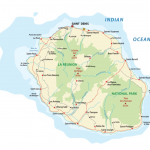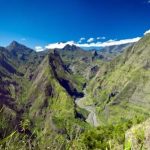
Fostering research excellence
in EU Outermost Regions


Fostering research excellence
in EU Outermost Regions

La Reunion is a French tropical volcanic island lying in the Mascarene Archipelago (Indian Ocean), one of the most preserved biodiversity hot spot in the world.
With 2,512 km2 of land and managing 315 058 km2 of marine exclusive economic area, La Reunion provides a unique presence of France and Europe at the crossroads of Africa and Asia, at the heart of a millenary world-system.
With these unique characteristics, advanced infrastructures and highly skilled human talent, La Reunion offers the opportunity for European researchers and entrepreneurs to develop innovative solutions contributing to the ecological and energy transition in tropical context.

With its preserved natural assets, La Reunion provides an exceptional living conditions and an outstanding fertile environment for research and economic development :
La Reunion at a glance:
Population: 866 000 (2019)
Annual population growth: 1.1% (2016)
Population density : 345 inhab.km2
Population under 20 years old : 31% of the total population (266 350 p.)
Isolated from the main maritime roads, but regularly visited by Arab sailors, La Réunion remained unpopulated until the early 17th century, when settlers recruited by the French East India Company founded the first permanent settlement with Malagasy and Indian people. This diverse, creole population was amplified by the plantation system which dominated the island and led to the introduction of thousands of slaves and indentured workers. Since the end of the 19th century, later migrations waves from China, India, Vietnam, France and the Comores have created a unique multicultural society.
La Réunion is today one of the youngest and fast-growing European Regions.
With more than 860 000 people today, the island’s population should reach 1 million by 2037.
Nominal GDP: €18,5 Billions (2017)
GDP per capita: €21,500 (2017)
GDP growth rate: 3.2% (2017), in current currency values
Exports of goods and services : 280 Millions euros
Economic structure in share of total added value : Market and Non market services (67%), Transport and distribution (16%), Construction (7%), Industry (8%), Agriculture and fisheries (1,4%).
The economy of La Réunion has been shaped by its integration in the French republic as an overseas department in 1946. This new status was accompanied by a thorough modernization policy designed to accelerate the convergence toward European standards. Supported by public funds, such strategy relied on the construction of world-class infrastructures, the reinforcement of human capacities, the consolidation of the sugar-cane industry and the development of local services and import-substitution activities. The emergence of a strong local market, pulled by a marked demographic expansion (from 227 to 852 000 inhabitants) and public expenditures, has supported a remarkable economic growth : between 1970 and 2010, the GDP was multiplied by almost 50 in value, growing from €306 million to €14,900 million. With 21 500€, the island now presents the highest GDP per capita of the Indian Ocean zone.
Despite this strong convergence, the island faces critical challenges. Its economy relies on national and European public transfers which account for 42% of its GDP. The accelerated growth of its metabolism and the introduction of mass consumption standards now exceed the carrying capacity of a small and fragile leading to high material and energy dependence toward imports as well as to the anthropization and degradation of its unique ecosystems and habitats. Social challenges are also remarkable : La Réunion struggles with a high-level of unemployment (24%) and mass poverty, half of the population living beyond the national poverty line.
Such economic, social, ecological and energy dependencies constitute major sources of vulnerabilities, which questions the very sustainability of its model. But they also offer opportunities to design innovative solutions for a resilient and inclusive future.
In a world of global competition and ecological collapse, La Reunion has launched an ambitious transformation programme to build a carbon-neutral, ecologically and socially resilient island. This strategy is based on a paradigm-shift which turns tropical islands characteristics, usually considered as handicaps, into fields of opportunities. As a densely populated and remote island with vulnerable ecosystems and few resources, La Réunion is indeed confronted today to a challenge that will concern tomorrow all regions : the need to design an ecological economy, inscribed in the capacities and rythms of natural ecosystems. The same logic applies to the conversion toward small-scale and self-consumption energy systems.
Through its smart specialization strategy, La Réunion is thus becoming a living lab for ecological and energy transition and seek to develop singular solutions, which both reduce its own vulnerabilities and satisfy the needs of other regions.
The island focuses its R&I efforts in world-recognized domains :
– biodiversity conservation and restoration in highly endemic systems
– earth and climate systems observation in the Indian ocean
– agro-ecological tropical food production and natural extracts
– energy transition in tropical island context
– tropical infectious and metabolic diseases prevention and therapies
The strategy is developed via a highly dense and dynamic research and innovation ecosystem:
# 34 academic labs and research centers with more than 440 public researchers
# cutting edge research facilities such as :
# a network of associations and clusters promoting and supporting businesses innovation
# fully-committed public institutions managing financial tools to support Research and Innovation